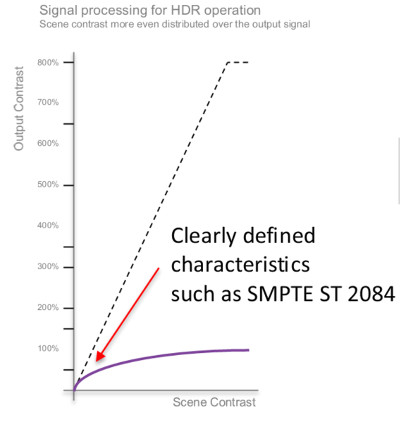Grass Valley’s Sr. product Manager for Cameras, Klaus Weber, recently hosted a webinar on HDR (High Dynamic Range) for live TV production and also gave a paper at the SMPTE conference covering similar ground. These provided a nice overview of the current HDR landscape and pointed to some Grass Valley products that were highlighted at the IBC event in Amsterdam.

The chart provides a nice overview on some of the UHD standards approved by DVB/EBU, ITU and SMPTE. Note that there are differences in the frame rates and bit depths, as well as the color space. There are some HDR standards, but their definition is unclear.
The UHD Phase 1 is the current deployment with no HDR support. UHD phase 2 is scheduled for 2017/2018. However, Amazon is already offering UHD content with HDR support, with Netflix and VUDU not far behind.
Most readers of our content now understand that HDR allows for expanded contrast capture and display and enables better definition in the dark and white parts of the image and a rise in peak luminance levels for the display. Many cinema grade cameras can acquire at 14-15 f-stops – the sort of accepted level of HDR capture at this time. But cameras for TV production with HDR capabilities are non-existent (unless you repurpose a cinema camera as some have done, but with a very short depth of field trade off).
Weber used an example of a football (soccer) match where players are in shadow in the foreground while the background stands are bathed in bright sunlight. If the cameraman opens the aperture to get good exposure on the players, the background will be washout (saturated the sensors) producing a bland white area with no details. HDR acquisition is designed to allow those bright details to become captured in real time without a post production process (or vise versa to bring out dark details).
So what do camera makers need to do to enable HDR capture? Weber says first of all that CMOS, not CCD technology should be used for the sensors.
Secondly, a global shutter not rolling shutter operation is needed. Global shutters capture light in all of the imaging pixels at the same time, then shut them all off simultaneously and transfer the data to an underlying set of transistors that can store and transfer the data out of the image during the next capture cycle. This also reduces the motion artifacts from rolling shutters where data is captured and output row by row in sequence. Grass Valley uses a sensor that allows for multiple read-outs during an exposure to achieve 15 F-stops of dynamic range.
Third is the use of large pixels that can capture more photons without saturating.
But HDR pipelines are not mature, so it makes sense to have dual pipelines for production purposes in the near term, which the Grass Valley camera supports.
Weber then discussed signal mapping – how the scene contrast is mapped to output video signal. Natural scenes have a lot of contrast – much more than the camera can output, so algorithms have been developed to map the scene contrast to the output video signal – the so called gamma curve. In standard dynamic range (SDR) video, the brightest elements are simply clipped, but that is not acceptable for HDR.
The SMPTE 2084 standard defines the PQ (Perceptual Quantizer) curve that is supposed to better match the human eye’s perception of contrast and create an algorithm for the mapping.

Other ways to perform this mapping have been proposed by the BBC, Technicolor, Philips and others, but these have yet to be standardized. The BBC approach is gaining special attention right now as it uses the SDR gamma curve up to the standard clipping point, but above that, a log curve is added for capturing brighter pixels. That allows the signal to be backward compatible to SDR equipment and displays and support HDR displays going forward. That’s a powerful value proposition, but it will not perform as well as some of the other proposed solutions.
As a result, Weber says their new HDR camera, the LDX 86, will come with support for ST 2084, and other mapping algorithms will be added later as they become standardized. The camera will have dual outputs that support an SDR and HDR workflow. This is handled in their baystation, the XCU Universe XF, that can output a HD/4K SDR stream and HD/4K HDR stream (in Quad SDI level A or B format or IP encapsulated using a 4:1 TICO compression).

Weber sees a strong value proposition for the broadcasters to consider offering a 1080p signal with HDR at 60 or maybe 120 fps. This would use less bandwidth than a UHD signal with or without HDR and would likely be just as impactful in the living room. However, Weber admits that everything with fewer pixels than UHD is viewed as inferior even if reality does not match perception.
Weber’s conclusions from his SMPTE paper included:
- Modified cameras can now capture close to the 2020 color gamut
- Smaller pixels deliver lower sensitivity and countermeasures have their side effects
- The perceived sharpness is only partly related to the pixel count as the MTF of the lenses has a big impact as well
- Motion blur limits the resolution on moving objects and shorter exposure time limit sensitivity and expose rolling shutter artifacts
- HDR capture offers multiple advantages in live productions including cost saving and more dependable results even in extreme lighting conditions

